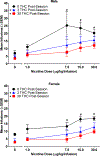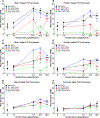Experimenter administered Δ9-THC decreases nicotine self-administration in a rat model
- PMID: 37690617
- PMCID: PMC10543614
- DOI: 10.1016/j.pbb.2023.173632
Experimenter administered Δ9-THC decreases nicotine self-administration in a rat model
Abstract
Background: The co-use of nicotine and cannabis has been steadily rising in the United States. Rodent studies suggest that delta-9-tetrahydrocannabinol (THC) could increase addictive qualities of nicotine, but whether repeated THC exposure alters self-administration of nicotine has not been tested. We hypothesized that THC would increase the reinforcing effects of nicotine and alter nicotine intake.
Methods: Adult male and female Sprague-Dawley rats were treated with THC (0, 3, 30 mg/kg) daily for 14 days prior to and during training for intravenous self-administration of nicotine. Rats were allowed to self-administer nicotine for several weeks, then tested for sensitivity to nicotine dose through multiple determinations of a nicotine dose-effect curve with or without THC pretreatment. A separate set of rats were trained on fixed ratio responding for sucrose and assessed for THC effects on behavior.
Results: Post-session THC decreased nicotine self-administration in male and female rats throughout acquisition and maintenance and increased the latency to stable rates of nicotine intake during acquisition. Post-session THC shifted nicotine dose-effect curves downward, and pre-session THC suppressed responding at higher nicotine doses. Unlike nicotine, responding for sucrose was not affected by post-session THC. Pre-session THC decreased responding for sucrose, particularly for THC-naïve rats.
Conclusions: Repeated post-session THC decreased nicotine-taking behaviors but did not alter sucrose responding. Thus, post-session THC may alter sensitivity to nicotine. Pre-session THC treatment decreased lever pressing in both sucrose and nicotine studies, indicating this effect was nonspecific. These studies show that THC modulates patterns of nicotine intake in rat models.
Keywords: Cannabis; Co-abuse; Delta-9-tetrahydrocannabinol; Nicotine; Polysubstance use; Self-administration.
Copyright © 2023 Elsevier Inc. All rights reserved.
Figures






Similar articles
-
Chronic nicotine exposure attenuates the effects of Δ9 -tetrahydrocannabinol on anxiety-related behavior and social interaction in adult male and female rats.Brain Behav. 2019 Nov;9(11):e01375. doi: 10.1002/brb3.1375. Epub 2019 Oct 3. Brain Behav. 2019. PMID: 31583843 Free PMC article.
-
Exposure to delta-9-tetrahydrocannabinol (THC) increases subsequent heroin taking but not heroin's reinforcing efficacy: a self-administration study in rats.Neuropsychopharmacology. 2004 Jul;29(7):1301-11. doi: 10.1038/sj.npp.1300431. Neuropsychopharmacology. 2004. PMID: 15039767
-
Prior exposure to THC increases the addictive effects of nicotine in rats.Neuropsychopharmacology. 2013 Jun;38(7):1198-208. doi: 10.1038/npp.2013.16. Epub 2013 Jan 11. Neuropsychopharmacology. 2013. PMID: 23314220 Free PMC article.
-
The opioid antagonist naltrexone reduces the reinforcing effects of Delta 9 tetrahydrocannabinol (THC) in squirrel monkeys.Psychopharmacology (Berl). 2004 Apr;173(1-2):186-94. doi: 10.1007/s00213-003-1693-6. Epub 2003 Dec 11. Psychopharmacology (Berl). 2004. PMID: 14668977
-
Nicotine Enhances Intravenous Self-administration of Cannabinoids in Adult Rats.Nicotine Tob Res. 2023 Apr 6;25(5):1022-1029. doi: 10.1093/ntr/ntac267. Nicotine Tob Res. 2023. PMID: 36426873 Free PMC article.
Cited by
-
The Rodent Electronic Nicotine Delivery System: Apparatus for Voluntary Nose-Only E-Cigarette Aerosol Inhalation.bioRxiv [Preprint]. 2025 Feb 4:2024.12.21.629932. doi: 10.1101/2024.12.21.629932. bioRxiv. 2025. Update in: J Exp Anal Behav. 2025 Mar;123(2):337-354. doi: 10.1002/jeab.70005. PMID: 39763771 Free PMC article. Updated. Preprint.
-
The rodent electronic nicotine delivery system: Apparatus for voluntary nose-only e-cigarette aerosol inhalation.J Exp Anal Behav. 2025 Mar;123(2):337-354. doi: 10.1002/jeab.70005. Epub 2025 Mar 14. J Exp Anal Behav. 2025. PMID: 40085141
References
-
- Arnold JM, Roberts DC, 1997. A Critique of Fixed and Progressive Ratio Schedules Used to Examine the Neural Substrates of Drug Reinforcement. Pharmacology Biochemistry and Behavior, 57(3), 441–447. - PubMed
Publication types
MeSH terms
Substances
Grants and funding
LinkOut - more resources
Full Text Sources

